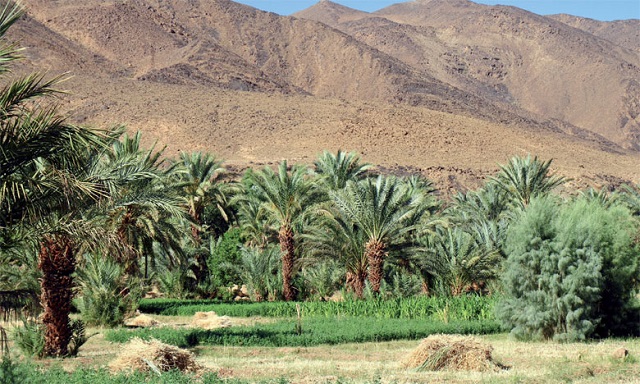The earth beneath Tamegroute is dry and cracked, its dusty surface broken in places like a parched mosaic. Just beyond the village, nestled in Morocco’s Zagora province, the palm trees strain to hold onto their green, while the old khettaras—those ancient underground irrigation tunnels—now carry little more than echoes of the past. Across the entire southeastern stretch of the country, drought is no longer seen as a passing hardship. It has become the new normal, forcing communities to shift their way of life in order to survive.
Abdelkader, a 52-year-old farmer, gestures toward his shrinking farmland. What used to be a field of wheat and alfalfa has been scaled down to a modest grove of hardy trees. “Now I only keep what can survive on very little water—pomegranate and olive trees,” he says. He’s managed to keep going thanks to a drip irrigation system, partially funded through a government grant. Without that, he admits, he would have walked away from farming long ago.
Across the region, this kind of shift in agricultural practice isn’t just common—it’s become essential. Water-intensive crops like cereals are disappearing, replaced by species that can handle the punishing conditions. The prickly pear cactus, once dismissed as a fringe crop, is now being cultivated widely. Local cooperatives have even set up processing workshops to create higher-value products from the fruit, turning survival into opportunity.
But not everyone can keep up with the pace of change. Just a few miles away, Aïcha, a widow raising three children, was forced to sell off her livestock last year. With no feed and barely enough water, she had no other choice. “Even the wells have gone down,” she says. “Now we wash our dishes with the same water we used for laundry.” In her small village, many families have already left, heading to nearby cities in hopes of finding work and stability.
In Zagora, water scarcity is no longer something people plan for—it’s something they live with every day. The province depends almost entirely on underground aquifers, which have been steadily shrinking for years. A few recent storms have offered brief relief, but the rain comes too suddenly and too rarely to truly restore the region’s balance. The Drâa River has dropped to record lows, wells are being drilled at an accelerating pace, and in some places, water is delivered only by tanker trucks. Back in July, local officials acknowledged the depth of the crisis and unveiled a regional action plan. But farmers on the ground say they’ve mostly watched their water sources dry up, forcing them to scale back operations or abandon fields altogether. While a desalination plant is in the works for Dakhla, southeastern communities are still waiting for concrete solutions closer to home.
The national agriculture ministry is focusing on awareness and education. It’s running training sessions for small-scale farmers on irrigation techniques, drought-resistant seeds, and the integration of renewable energy into farming. Financial aid is also available, but for many, navigating the bureaucracy—especially without fluency in formal Arabic or access to online systems—makes that support frustratingly out of reach.
Still, amid dying palm groves, a few younger farmers are trying to breathe life back into the land with modern methods: composting, mulching, water storage, and agroforestry. Hicham, an agronomy graduate who returned to the Drâa Valley to apply his skills, puts it simply: “It’s a gamble. But if we don’t change things now, there won’t be anything left for the next generation.”
In a landscape where water is vanishing, farming is evolving—fast. It’s a race against a changing climate, fought with limited tools but relentless determination to stay rooted to the land.
